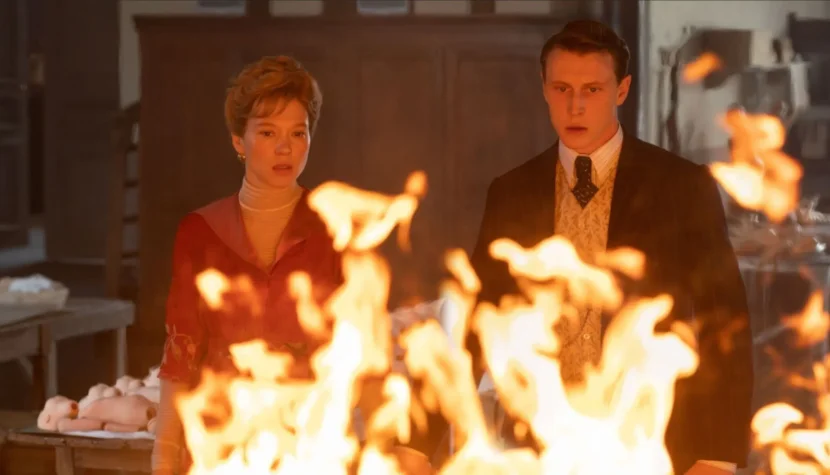THE BEAST. Love, Longing, and Artificial Intelligence [REVIEW]

Love is eternal, but it is not the only thing that lasts. Over the centuries, alongside noble passion, other emotions accompany it—sorrow, regret, or anger. In the postmodern world, as people become increasingly trapped in a life deadlock, gripped by new technologies offering only the illusion of happiness, there is a growing melancholic longing for the past, for lost opportunities and potential. Bertrand Bonello’s latest film “The Beast” touches precisely on this feeling, intensified by a journey into the future, to the not-so-distant year 2044, when society is controlled by artificial intelligence.
Bonello is one of the most interesting contemporary creators of auteur cinema. His filmography spans a wide spectrum of conventions, from post-New Wave experiments like his debut “Pornographer”, to the stylish melodrama “House of Tolerance”, the semi-mainstream biopic “Saint Laurent”, the enigmatic crime-thriller “Nocturama”, the magic realism-infused “Zombi Child”, and the avant-garde essay-like “Coma”. “The Beast” is in many ways his tour de force, showcasing his directorial eclecticism and courage in exploring different, often disparate conventions. At one point, this new film was actually intended to be three separate projects, but production complications transformed it into one. It may also be Bonello’s most ambitious project, realized with an exceptional scale for him, based on a concept he had been developing for nearly a decade.

The framework of “The Beast” revolves around the process of eliminating emotions, which Gabrielle undergoes under the advice of a rational voice from an artificial overseer. This initiates a journey for the woman through time and space, through her previous incarnations. Bonello weaves the story between three timelines—the waning “belle époque”, the present day, and the future, which is the heroine’s current reality. The thread connecting all three of Gabrielle’s incarnations is her relationship with the mysterious Louis, who appears out of nowhere, only to assume new roles like a chameleon, circling around her as an eternal lover.
Léa Seydoux and George MacKay, who play the main roles, truly stretch themselves in this film, creating multiple incarnations of their characters simultaneously. The time shifts and character changes, all tied to the same faces, present a significant challenge for the actors, but with such talented professionals as Bonello’s chosen duo, it also allows them to shine. Both the French actress and the English actor deliver phenomenal performances, making the acting perhaps the greatest asset of “The Beast”. Also worth noting is a cameo by Elina Löwensohn as a clairvoyant, who adds a layer of ambivalence, even occult darkness, to the plot. The sequences where Bonello creates a dreamlike, ominous atmosphere of traveling through the dark corners of time and memory are among the most captivating in his new film. Unfortunately, this aspect of “The Beast” is often drowned in the flood of time jumps and aesthetic flourishes that, while visually appealing, constrain the film, preventing it from gaining momentum. And when it does, it is quickly subdued back into sluggishness in the next sequence.

Stylistically, “The Beast” is an amalgam of three different formal identities. There is the classic, salon-style costume drama (with philosophical dialogues that at times evoke Cristi Puiu’s “Malmkrog”), a somewhat Lynchian thriller about a girl dreaming of Hollywood, and a futuristic psychodrama pondering the boundaries of humanity and the course of history. Individual fragments of each of these intertwined segments are fascinating, and Bonello, a master of staging, crafts several enthralling sequences that evoke a surreal, specific spectacle. Unfortunately, the French director also tries too hard to stitch his story together with narrative consistency, often abandoning the cross-genre tension in favor of excessive exposition and overdeveloping plotlines that could have been left more ambiguous. As a result, “The Beast” falls apart in many places, with its individual parts held together more by duct tape than by a precise stitch. It’s hard to escape the impression that Bonello himself was overwhelmed by the hybrid formula and couldn’t quite manage it, allowing the titular beast to partially consume him.
Despite its shortcomings, it’s worth applauding Bonello’s artistic persistence in realizing his vision. It’s not an outright failure; rather, it’s a film that doesn’t fully realize its potential. The fact that it could have been better doesn’t mean it’s bad—paradoxically, that is also one of the conclusions drawn from the story of Gabrielle and Louis. In Bonello’s filmography—which, hopefully, will continue to grow with more intriguing and perhaps more coherent works—”The Beast” will hold a significant place as a major project, a puzzle-like film that showcases the creator’s creativity. For that reason alone, “The Beast” is worth watching, worth confronting on your own, as it’s a rare example of cinematic flair and finesse, even if not always effective, but always beautiful to look at.

